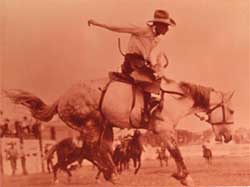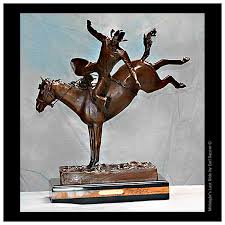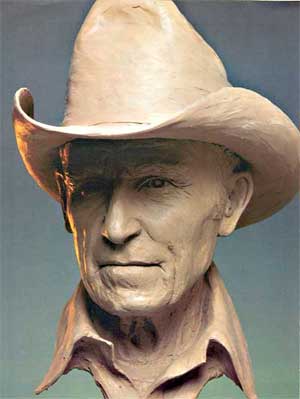Earl Bascom
Earl Wesley Bascom was aptly called a “renaissance cowboy.” Born in Vernal, Utah, in 1906 and raised in Alberta, Canada, Bascom was brought up to understand and manage cows and horses. “He worked on some of the largest horse and cattle ranches in the United States and Canada, worked on cattle drives out of the Rockies and trailed horses over the Teton Mountains.” His father, John W. Bascom, had been a deputy sheriff in Utah who chased Butch Cassidy and the Wild Bunch Gang. Both sets of Earl's grandparents (Joel A. Bascom and C.F.B. Lybbert) were Mormon pioneers, ranchers and frontier lawmen. [1] [3] As a child growing up, he was sometimes affectionately addressed by his British-born aunts as "Lord Bascom - King of the Canadian Cowboys," as he was a descendant of European royalty back to Charlemagne. [3]
Between the years of 1916 and 1940, Bascom was a rodeo champion. He won second place in the North American Championship and placed third in the rodeo Championship of the World. Bascom participated in every aspect of rodeo competition— “including bareback, saddle bronc, bull riding, steer riding, steer wrestling, steer decorating, wild cow milking, and wild horse racing. He also worked as a rodeo producer, stock contractor, rodeo announcer, pickup man, hazer, rodeo clown and bullfighter.” [1]
Adding to his Renaissance-man stature, Bascom was an inventor and designer. In 1916, at their ranch in Welling, Alberta, Canada, Earl and his brothers, Raymond, Melvin and Weldon, designed and built history's first side-delivery rodeo chute. In 1919 Earl and his father, John W., designed and built rodeo's first reverse opening rodeo chute. Earl created the first hornless bronc saddle (1922) and the first one-hand bareback rigging (1924), which are still in use worldwide. Rodeo's first high-cut riding chaps were devised by Bascom in 1926, and are also still in use today.
Rodeo-ing in Columbia, Mississippi, Bascom held the first rodeo at night under electric lights and established the first permanent rodeo arena in the area. Earl earned the distinction of being called rodeo’s first collegiate cowboy, as he worked his way through Brigham Young University, graduating in 1940. After graduation Bascom and his wife, Nadine Diffey Bascom, left Utah for southern California, finally settling in Hesperia in San Bernardino County. In the early 1960’s Bascom began taking art classes at Victor Valley College. Not one to go at something half-bore, Bascom became the president of the High Desert Artists local art club. Always keen on continuing education, Earl and Nadine spent a year back in Utah, where Nadine earned a degree at BYU and Earl qualified for a lifetime teaching certificate. They settled in Victorville in 1966.
Both Earl and Nadine became teachers, with Nadine teaching elementary school and Earl teaching high school art classes. It didn’t take long before Earl retired to spend full time at his artistic pursuits. Earl took sculpture and bronze casting at UC Riverside, and that launched him into another field of art.
- A cousin to Western artists Charles M. Russell and Frederic S. Remington, he became an internationally known Western artist and sculptor. In fact, Earl was the first cowboy elected a Fellow of the prestigious Royal Society of Arts of London, England, and the oldest cowboy ever elected a member of the Professional Rodeo Cowboy Artists Association. [1]
- [Bascom] worked a bit in the movie industry with his brother Weldon Bascom in the Hollywood western, "The Lawless Rider", starring Weldon's wife Texas Rose Bascom. Later Bascom and his son-in-law Mel Marion did TV commercials with Roy Rogers for the Roy Rogers Restaurant chain. Earl and his son John Bascom were in the video documentary "Take Willy With You" recording the life of Turk Greenough and the rodeo riding Greenough family. When the Roy Rogers Riding Stables opened up in Apple Valley, California, Earl and his son John worked there wrangling horses and driving the hay wagon. [3]
Earl Bascom's name is listed in Who's Who in American Art, Who's Who in Western Writers of America, Who's Who in the West, Who's Who in California, Who's Who in America, and Who's Who in the World. He was inducted into the Alberta Sports Hall of Fame for his rodeo prowess and pioneering inventions that changed the sport and rodeo world. Recently in Utah, the Ogden Pioneer Heritage Foundation hosted the 2013 Utah Rodeo Hall of Fame ceremonies at Ogden’s Union Station, where Earl Bascom was inducted into that hall of Fame as an athlete, artist and inventor. [2] Proving that talent runs in the family, entertainment was provided by Bascom’s grandchildren, Juliette Bascom and the Bascom Ranch Band.
In August 2014, Bascom was honored posthumously with the 2014 Cowboy Keeper Award as part of the National Day of the Cowboy celebration. The award is given annually to those who promoted and preserved the cowboy way of life.[1] In June 2015, Bascom was again honored when he was the first bull and bronc rider and the only cowboy artist ever inducted into Canada's Sports Hall of Fame, the highest sporting achievement in Canada.
Earl Bascom has been called the "Father of Modern Rodeo.” His son, John Bascom, an historian and artist himself, remembers him as an extremely talented, but humble, down-to-earth man. In addition to everything else he succeeded in, Earl Bascom was a dedicated Latter-day Saint who served in many responsible callings in The Church of Jesus Christ of Latter-day Saint’s lay clergy.
Earl Bascom died in 1995 at the age of 89 at his California ranch. His son John learned bronze casting while studying at Brigham Young University. After he graduated in 1972, he came back to Victorville and set up a bronze casting foundry, the first in the valley, to cast his father's beautiful art work. [1]
Sources:
- 1. Cowboy Legend Earl Bascom Was a Rodeo Pioneer and Western Artist — The Sun
- 2. Honoring a Renaissance Cowboy
- 3. Wikipedia
- 4. Earl Bascom's National Award


